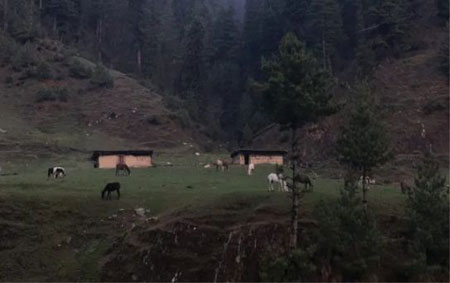Shadab Farooq and Anzer Ayoob
The delimitation panel was formed in March 2020, and it was given a two-month extension to finish redrawing Assembly constituencies in Jammu and Kashmir last month, until May 6. Delimitation is the process of redrawing boundaries to reflect population changes over time. On 5 May, the commission submitted and signed the final draft.
Six additional constituencies in Jammu and one in the Kashmir Valley have been included in the plan, which was published in the Gazette of India and the Gazette of Jammu and Kashmir. It also proposes that the territory be divided into seven scheduled castes and nine scheduled tribal constituencies.
The delimitation commission did not make any more revisions to its J & K delimitation draft proposal, which was last discussed with the five UT MPs who are also associate members on February 25.
In the granted proposal, the total number of Assembly constituencies is increased from 83 to 90, with 43 in Jammu and 47 in Kashmir; 24 seats have been reserved (and unoccupied) for Pakistan-controlled Kashmir.
Rejected as Unacceptable and Discriminatory. The Congress’s Jammu and Kashmir unit has expressed strong opposition to the final draft of delimitation, claiming that it is “dissection, not delimitation,” and that it “completely ignores ground realities.”
The proposal has been dubbed “unacceptable” and “discriminatory” by political circles in Jammu & Kashmir. Hasnain Masoodi, a senior National Conference leader and one of the group’s three associate members in a report, said, “I personally went to the Commission Secretariat and handed over the objections lodged by NC Associate members to the draft proposals.”
Public protests over earlier drafts. After the commission’s second draft, hundreds of BJP local officials and volunteers quit in protest against the proposed merger of the Suchetgarh and RS Pura constituencies in Jammu, the Hindu heartland of Jammu and Kashmir.
Several protests were staged in Kishtwar district of Chenab on February 9, 2022. On speaking, people said, “this is injustice for people, villages are merged with areas that are very far kilometres away in hilly terrains.
“The absence of connectedness and geographical proximity in the delimited constituencies is the major objection that we are raising”. Saffronizing Chenab and Pir Panjal to saffronize Jhelum. “By identifying Hindu-Muslim voters in Chenab and Pir Panjal districts, the ‘cracking’ approach to gerrymander is being used, said Mehraj Malik”, a young local leader and activist. “The delimitation plan redraws the twin districts of Doda and Kishtwar, which have cultural and ethnic ties to Kashmir valley, separating the majority and polarizing the minority”.
The old Kishtwar constituency in Chenab Valley includes 42,100 Hindus and 44,500 Muslims, according to the 2011 census. According to a recent report by Deepak Sharma of the Times of Kishtwar, based on the 2011 census, the new suggested redrawing of Kishtwar constituency will have 39,500 Hindus and 27,700 Muslims.
Padder is a new electorate containing three areas: Padder, Nagseni, and Poochal (all three were wiped from the old Kishtwar constituency), making it a Hindu majority constituency with 22,000 Hindus and 13,000 Muslims, according to the 2011 census.
Eager for a Hindu Chief Minister “The merging of seven assembly segments, with the new Anantnag Lok Sabha constituency in Kashmir, including the entire Poonch district and some areas of Rajouri district, which were previously part of the Jammu Lok Sabha constituency, is a packing technique used by the ruling government, based on reservation, to allow the BJP to enter the Kashmir mainland,” Malik said.
Advocate Sheikh Nasir, who is a senior lawyer and politician from Kishtwar, said, “The newly created Paddar constituency is fully Hindu-dominated and created with nearly 50 thousand voters, and the Hindu-dominated areas of the old Inderwal constituency, including Mulchiter and the Kuntawara belt, have been added to Kishtwar, transforming the Muslim-majority Kishtwar constituency into a Hindu majority”.
“Also, a village adjacent to Kishtwar town, which is the native village of former MLA and BJP leader Kishtwar, has been added to Paddar to make it a secure seat for him”, Nasir added. According to the 2011 Indian Census, Muslims make up 68.31% of the J&K population, with the majority of Muslims living in the Muslim belt of Kashmir and Jammu. Hindus make up 28.44% of Jammu’s population, mainly concentrated in four districts.
“If the BJP succeeds in electing a Hindu chief minister in the country’s only Muslim-majority state, it will gain a huge stake in the nation’s 2024 parliamentary elections, raising the prospect of high expectations,” Malik said. Organizing events to gather votes for BJP
After the final delimitation draft was signed, On May 24, Shraddhanjali-Sankalp Sabha was organized by J&K People’s Forum to pay tribute to the people killed during militancy. In a video of the event covered by Chenab Times, Dinesh Anand Bharti addresses a massive gathering stating “every Hindu youth should have five to six weapons at home and to vote for BJP”.
G.M Saroori, the ex-representative of the Inderwal Constituency said, “The delimitation draft is mapped as if remapping a human body where the head is fixed in place of feet and vice-versa, making it undemocratically absurd”.
On May 13, the Supreme Court invited comments from the Central government and the Jammu and Kashmir government in response to a petition contesting the delimitation process. The government has six weeks to file its affidavit, while the petitioners have two weeks to write their response. The Indian Election Commission has also been invited to respond to the petition. The date for the trial has been scheduled for August 30.
—Courtesy Maktoob Media










